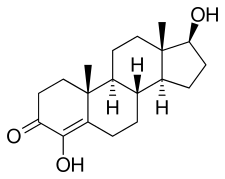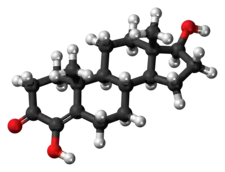4-Hydroxytestosterone
 | |
 | |
| Clinical data | |
|---|---|
| Other names | 4,17β-Dihydroxyandrost-4-en-3-one; Androst-4-ene-4,17β-diol-3-one; Desmethylenestebol |
| Identifiers | |
IUPAC name
| |
| CAS Number | |
| PubChem CID | |
| DrugBank | |
| ChemSpider | |
| UNII | |
| CompTox Dashboard (EPA) | |
| Chemical and physical data | |
| Formula | C19H28O3 |
| Molar mass | 304.430 g·mol−1 |
| 3D model (JSmol) | |
SMILES
| |
InChI
| |
| | |
4-Hydroxytestosterone (4-OHT), also known as 4,17β-dihydroxyandrost-4-en-3-one, is a synthetic anabolic-androgenic steroid (AAS) and a derivative of testosterone that was never marketed. It was first patented by G.D. Searle & Company in 1955 and is testosterone with a hydroxy group at the four position. 4-OHT has moderate anabolic, mild androgenic, and anti-aromatase properties and is similar to the steroid clostebol (4-chlorotestosterone).
See also
- 4-Androstene-3,6,17-trione
- Androstenedione
- Enestebol
- Formestane
- 11β-Hydroxytestosterone
References
This article is issued from Offline. The text is licensed under Creative Commons - Attribution - Sharealike. Additional terms may apply for the media files.